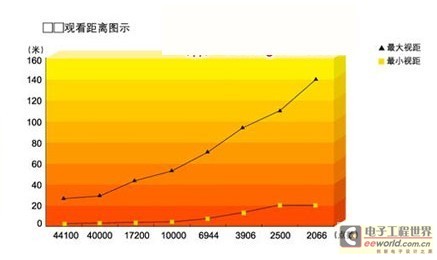Analysis of related indicators of LED display 1) Physical indicators Pixel center distance from pixel pitch The distance between the centers of adjacent pixels. (Unit: mm) Density (points) The number of pixels per unit area (unit: point / m2). There is a certain computational relationship between points and the same point spacing. The calculation formula is: density = (1000 ÷ pixel center distance). The higher the density of the LED display, the sharper the image and the smaller the optimal viewing distance range. Optimum line of sight View distance icon Level up degree The unevenness of the light-emitting diode, the pixel, the display module, and the display module when forming the plane of the LED display screen. The flatness of the LED display is not easy to cause the screen to be uneven in color when viewed. 2) Electrical performance indicators Gray scale The brightness level of the LED display that can be distinguished from the darkest to the brightest in the same level of brightness. Grayscale, also known as gradation or grayscale, refers to the degree of brightness of the brightness. For digital display technology, grayscale is the determining factor in the number of colors displayed. In general, the higher the gray level, the richer the displayed color, the finer the picture, and the more detailed the details. The gray level depends mainly on the number of A/D conversion bits of the system. Of course, the system's video processing chip, memory and transmission system must provide support for the corresponding number of bits. Generally, there are no gray scale, 8 grade, 16 grade, 32 grade, 64 grade, 128 grade, 256 grade, etc. The higher the gray scale of the LED display, the richer the color, the more vivid the color; on the contrary, the display color is single, the change simple. At present, the domestic LED display mainly adopts an 8-bit processing system, that is, 256 (28)-level gray scale. A simple understanding is that there are 256 brightness variations from black to white. RGB × 256 × 256 = 16,777,216 colors can be formed by using RGB three primary colors. That is, the so-called 16 mega color. The international brand display mainly adopts a 10-bit processing system, that is, 1024-level gray scale, and RGB three primary colors can constitute 1.07 billion colors. Frame rate LED display LED display screen information update frequency. Generally, it is 25 Hz, 30 Hz, 50 Hz, 60 Hz, etc., the higher the frame changing frequency, the better the image continuity of the change. Refresh frequency The LED display shows the number of times the data is repeatedly displayed every second. Usually 60Hz, 120Hz, 240Hz, etc., the higher the refresh rate, the more stable the image display. 


